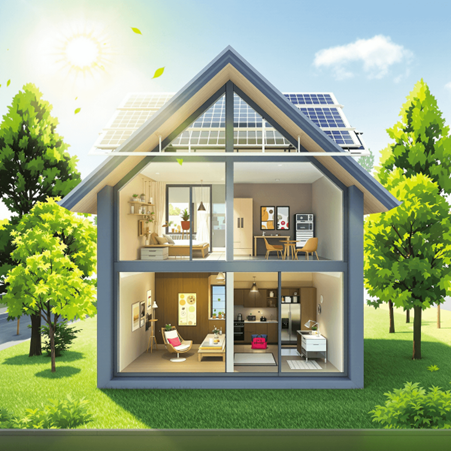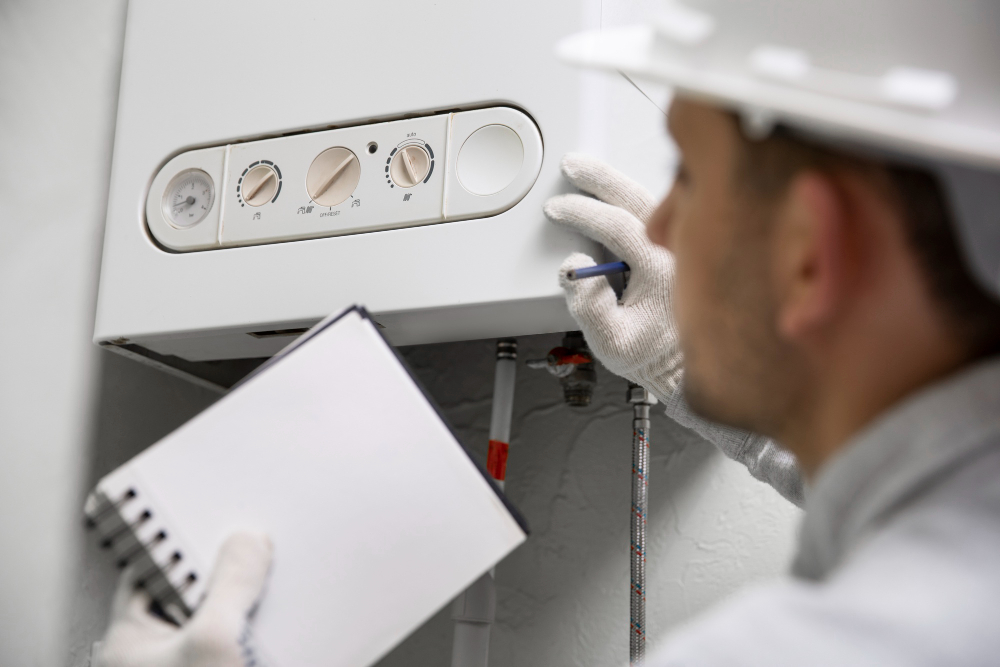Making your home more sustainable isn't just a trend - it's a smart investment that pays dividends for both your wallet and the planet. As we step into 2025, homeowners have unprecedented opportunities to transform their living spaces into energy-efficient havens.
Key Benefits of Sustainable Home Improvements:
• Lower monthly utility bills
• Increased property value
• Reduced carbon footprint
• Enhanced home comfort
• Tax incentives and rebates
The landscape of home improvement has evolved dramatically, with cutting-edge technologies making eco-friendly upgrades more accessible than ever. From advanced heat pumps to smart energy management systems, these improvements offer practical solutions for modern homeowners.
2025 brings exciting developments in sustainable home upgrades:
• Energy-efficient windows and doors
• Smart thermostats and home automation
• Solar panel installations
• High-performance insulation systems
• Water conservation fixtures
These improvements create a win-win situation: you save money while contributing to environmental conservation. With federal tax credits, state rebates, and long-term energy savings, sustainable home improvements have become an essential consideration for forward-thinking homeowners.
1. Federal Tax Credits for Energy-Efficient Upgrades
The U.S. government offers substantial tax credits to homeowners who invest in energy-efficient improvements. Starting 2025, these credits require a manufacturer-issued PIN number for eligible products.
Key Eligibility Requirements:
• Primary residence located in the United States
• Improvements must meet specific energy efficiency standards
• Installation must be completed by certified professionals
• Products must carry proper certification labels
Qualifying Energy-Efficient Upgrades:
• Heat pumps (up to $2,000 credit)
• Energy-efficient windows ($600 maximum)
• Exterior doors ($500 maximum)
• Insulation and air sealing materials ($1,200 maximum)
• Home energy audits ($150 maximum)
• Electrical panel upgrades ($600 maximum)
• Biomass stoves and boilers ($2,000 maximum)
The federal tax credit program allows homeowners to claim up to 30% of qualifying costs, with a maximum annual limit of $3,200. These credits remain available through 2032, providing ample opportunity for strategic home improvements.
Annual Credit Limits:
• $1,200 for most improvements
• Additional $2,000 for heat pumps and biomass stoves
• Credits reset each year
• No lifetime maximum
These tax credits work as a dollar-for-dollar reduction in your tax liability, making energy-efficient upgrades significantly more affordable.
2. State and Local Rebates and Programs
State and local governments offer substantial rebates and incentives to make sustainable home improvements accessible to all homeowners. These programs complement federal tax credits and create additional savings opportunities.
Popular State Rebate Programs:
• Utility company rebates for energy-efficient appliances
• Weatherization assistance programs
• Solar panel installation incentives
• Smart thermostat rebates
• Water conservation upgrades
Many states prioritize support for low- and middle-income families through targeted programs:
"Income-qualified households can receive up to $14,000 in rebates for energy-efficient upgrades, covering 50-100% of project costs"
Key Benefits for Income-Qualified Households:
• Higher rebate percentages
• Zero-interest financing options
• Free energy audits
• Direct installation services
• Additional utility bill assistance
State programs often partner with local contractors and retailers to offer instant rebates at the point of purchase. This immediate discount eliminates the need to wait for reimbursement, making upgrades more affordable upfront.
To find available programs in your area:
1. Contact your utility provider
2. Visit your state energy office website
3. Check DSIRE (Database of State Incentives for Renewables & Efficiency)
4. Consult local home improvement retailers
These location-specific incentives can significantly reduce the cost of sustainable home improvements when combined with federal tax credits.
3. Energy Efficient Home Improvement Credit
The Energy Efficient Home Improvement Credit offers substantial financial benefits for homeowners investing in eco-friendly upgrades. This nonrefundable credit allows you to claim up to 30% of qualifying costs annually.
Qualified Improvements Include:
• Heat Pumps: Air-source and ground-source systems
• Energy-Efficient Windows: Triple-pane or ENERGY STAR certified
• Insulation: Meeting or exceeding building code requirements
• Exterior Doors: Energy-rated models
• Electric Panels: Upgrades to 200+ amp service
• Home Energy Audits: Performed by certified professionals
Credit Claiming Process:
1. Keep detailed records of purchases and installations
2. Obtain manufacturer certification statements
3. Verify product eligibility through ENERGY STAR database
4. Complete IRS Form 5695 with tax return
Annual Limitations:
• $600 for exterior windows and skylights
• $500 for exterior doors
• $2,000 for heat pumps and biomass stoves
• $150 for home energy audits
• Maximum annual credit: $3,200
The credit applies to improvements made after January 1, 2023, with no lifetime limit. Starting 2025, eligible products must include a manufacturer-issued PIN number for tax credit claims.
4. Common Sustainable Home Improvements You Can Make Today!
Ready to transform your home into an energy-efficient haven? Here are the most impactful sustainable improvements you can implement:
1. Heat Pumps
• Energy Savings: Up to 50% reduction in heating/cooling costs
• Pros: Year-round climate control, reduced carbon footprint
• Cons: Higher upfront installation costs, may need backup heating in extreme cold
2. Energy-Efficient Windows
• Energy Savings: 15-30% reduction in energy bills
• Pros: Enhanced home comfort, noise reduction, UV protection
• Cons: Significant initial investment, installation complexity
3. Home Insulation
• Energy Savings: 15-50% reduction in heating/cooling costs
• Pros: Immediate comfort improvement, noise reduction
• Cons: Installation can be disruptive, requires professional assessment
4. Smart Thermostats
• Energy Savings: 10-12% on heating, 15% on cooling
• Pros: Remote control capability, learning algorithms
• Cons: Requires Wi-Fi connection, initial programming setup
5. LED Lighting
• Energy Savings: 75% less energy than traditional bulbs
• Pros: Long lifespan (25,000+ hours), instant brightness
• Cons: Higher upfront cost per bulb, specific dimmer requirements
These improvements create a synergistic effect when implemented together, maximizing your home's energy efficiency while reducing utility bills. The combination of proper insulation, efficient windows, and modern heating/cooling systems can transform your living space into a model of sustainable living.
5. Standards and Requirements for Sustainable Home Improvements
Meeting specific energy efficiency standards is crucial for qualifying for federal tax credits and rebates. Here's what homeowners need to know:
ENERGY STAR Requirements:
• Products must carry the ENERGY STAR certification
• Windows and doors require specific U-factor and Solar Heat Gain Coefficient ratings
• Heat pumps must meet minimum Seasonal Energy Efficiency Ratio (SEER) values
• Appliances need to achieve designated energy consumption thresholds
Property Qualifications
• Home must be taxpayer's primary residence
• Property must be located within the United States
• Existing homes qualify; new construction typically doesn't
• Rental properties may have different eligibility criteria
Documentation Requirements:
• Manufacturer's certification statement
• Product identification numbers (PINs) starting 2025
• Detailed receipts showing:
• Purchase date
• Installation costs
• Product specifications
• Energy audit reports from certified professionals
Building Code Compliance:
• Insulation must meet or exceed International Energy Conservation Code
• Electrical upgrades need to follow National Electrical Code standards
• Local building permits may be required for certain improvements
• Professional installation documentation for complex systems
These standards ensure improvements deliver meaningful energy savings while maintaining safety and performance benchmarks. Each upgrade category has specific technical requirements that must be met to qualify for incentives.
6. Incentive Duration and Expiration Dates
The timeline for sustainable home improvement incentives spans through 2032, with specific programs following different schedules:
Federal Tax Credits:
• Energy Efficient Home Improvement Credit runs until December 31, 2032
• Annual claim limits reset each year
• No lifetime maximum cap
State and Local Programs:
• Varying expiration dates based on:
• Available funding
• Program popularity
• State budget cycles
• Legislative changes
Key Factors Affecting Duration:
• Market adoption rates
• Technology advancements
• Environmental policy changes
• Economic conditions
• Energy price fluctuations
Pro Tip: Check your local utility company's website quarterly for updated incentive programs and deadlines, as new opportunities often emerge throughout the year.
Conclusion:
Sustainable home improvements are a smart investment for your property's future. With utility bill savings and financial incentives available, there's a strong case for making eco-friendly upgrades. These improvements offer:
• Reduced monthly energy costs
• Increased home value
• Enhanced comfort year-round
• Smaller carbon footprint
• Long-term financial returns
In 2025, there will be even more opportunities with tax credits, rebates, and new renewable energy technologies. It's important to take action now - with current incentives and advancing technology, homeowners can make their homes more energy-efficient and reap significant financial benefits. Instead of letting your home waste energy, make it work smarter by embracing these sustainable solutions.




